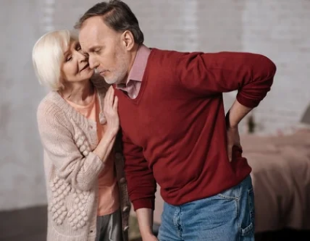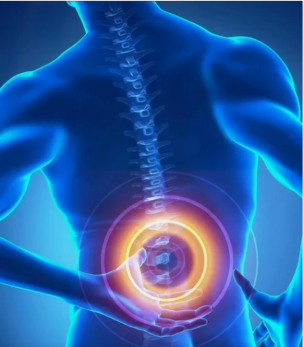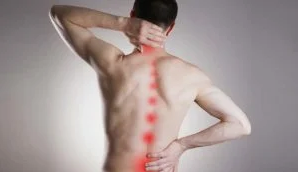Pathology has certain features that are significantly different from those that are characteristic of the degradation of bone tissue in individual zones and departments. The set of symptoms of common osteochondrosis, characterizing the overall clinical picture, is as follows:
- Significant sharp deterioration in vision and hearing;
- Dizziness, lack of coordination of movements;
- Diseases of the oral cavity, tooth loss, flushing of the skin;
- General weakness, rapid body fatigability, even with the smallest physical exertion;
- Pain in the chest, under the scapula, in the shoulder joints, radiating to the upper limbs.
Widespread osteochondrosis can be localized in one area of the spinal column, affecting several joints and cartilage. The signs of such pathologists are individual, and clearly characterize the affected area. For example, a disease in the thoracic region has pronounced symptoms:
- Pain and shortness of breath in the region of the heart associated with the development of intercostal neuralgia;
- Limitations of neck and arm movements;
- Severe pain during sudden movements of the arms and torso, sneezing and coughing;
- Diseases of internal organs.
Symptoms of generalized lumbar osteochondrosis:
- Numbness in lower limbs and lumbar region;
- Pain in the pelvic region, passing into the buttocks and legs;
- Spasmodic attacks in the area of osteochondrosis localization;
- Diseases of the internal organs of the pelvis associated with difficulty urinating, difficulty defecating or, conversely, incontinence of urine and feces.
Considering that widespread osteochondrosis of the spine manifests itself in each specific case in different ways, and provokes exacerbations associated not only with the skeletal system, but also with internal organs, only a specialist can diagnose the disease. During the examination, the doctor will definitely prescribe an MRI scan, which will reveal pathological processes in the entire spine, and will prescribe an effective treatment.
Common osteochondrosis of the spine: treatment
Treatment of common osteochondrosis is conservative. In addition to the qualifications of the doctor, the patient himself plays an important role in the treatment. More precisely, his efforts. Therapeutic measures are planned based on the area of localization of changes of a degenerative-dystrophic nature. Since the localization of the pathological process is expanded, you need to understand that the treatment will be long.
The complex of therapeutic measures includes manual therapy, physiotherapy, acupuncture, therapeutic exercises and pharmacological treatment.
Therapeutic exercises for advanced osteochondrosis or exercise therapy is an important part of successful treatment. But it is necessary to do it only under the supervision of a qualified instructor. During exacerbations, exercise should be avoided as complications may arise. Consider a few exercises to relieve muscle tension:
- In a standing position, tilt your head to the right and left, holding for 5-10 seconds. Repeat 10 times.
- Move your shoulders back and forth in a circular motion. Repeat 7-10 times.
- Make some left and right torso bends.
There are also extremely severe cases, of which about 7%. They may require surgery. Surgical treatment of osteochondrosis is traumatic and difficult. Even a high qualification of a surgeon cannot be a complete guarantee of success in this case. So do not take the disease to an extreme. At its initial signs, you should immediately consult a doctor and follow all his recommendations, change your lifestyle and take preventive measures.
Sacral osteochondrosis and its symptoms

In cases of sacral osteochondrosis, complaints come to pain in the lower back and sacrum, in the direction of the sciatic nerve. At the same time, there is a decrease in the temperature of the lower extremities and a decrease in their sensitivity. Sometimes, with sacral osteochondrosis, the so-called "radicular pain" occurs, that is, a kind of "lumbago" in the patient's leg from the hip to the tips of the toes.
A symptom of sacral osteochondrosis is also pain in the posterior region of the surface of the lower limb, radiating to the heel of this leg and along the outer edge of the foot, while the effect of numbness is also noted there. Well, due to disturbances in the vessels in the lower leg, the effect of chilliness and cold snap appears.
In addition to the already indicated symptoms of sacral osteochondrosis, many patients develop various disorders of motor functions, that is, paresis of some muscle groups located in the lower leg, and the Achilles reflex may be absent from the side of the disease.
The examination also reveals the following known symptoms of sacral osteochondrosis:
- when the patient's straightened leg rises, then from the side of the lesion there is an increase in pain in the lumbar region, in the buttocks, and also on the back of the thigh - that is, the Lasegue symptom;
- with a sharp tilt of the patient's head forward, pain in the leg and lower back intensifies - Neri's symptom;
- at the moment of assuming a sitting position from lying on the back, the leg, on the side of the lesion with the ailment, experiences a flexion reflex, that is, ankylosing spondylitis;
- when coughing, sneezing or other straining, there is an increasing pain in the lumbar region of the back - the so-called Dejerine symptom;
- on examination, from the side of the affliction, the effect of smoothing the folds on the buttock fold is a Bonnet symptom.
General guidelines for back health.
- Diet for osteochondrosis. Nutritional therapy provides the body with the substances necessary for the restoration of damaged cartilage tissues. There are no specific prohibitions on any products. You should reduce the consumption of fatty, spicy, salty, smoked foods and increase fruits and vegetables. The main requirement for proper nutrition will be the variety and balance of dishes.

- Exercise. Regular performance of individually selected exercises in accordance with the level of damage and the stage of the disease helps to alleviate the condition and stop the development of the pathological process. At the onset stage of the disease, remedial gymnastics can accelerate the recovery of damaged cartilage, which can lead to complete recovery.
To maintain the body in good physical shape, you can choose any direction of sports: running, swimming in a pool, cycling, running onskiing and rollerblading, dancing, yoga, qigong.
When choosing your sport, you should take into account the effect of the activity on the body. - Hypothermia and stressful situations should be avoided.
- Adequate stress on the spine. Sharp turns, tilts, lifting and carrying weights should be avoided. If heavy work is required, safety precautions must be followed. Monitor your back. When an overstrain appears in a certain muscle group, it is necessary to take measures to relax. Sedentary work is the same. Regardless of the type of activity, rest and work should be alternated. Throughout the day, regardless of the type of activity, monitor the correct position of the body in space, straight posture, adherence to biomechanics when lifting weights. These simple rules of conduct require human attention, self-control is necessary at all times.
- Corsets should be worn for spinal disorders, especially during strenuous physical activity.
- Quitting alcohol and smoking.
- Properly matched sleep equipment: firm pillow, medium firm mattress, bed with a firm base for sleeping.
- Wearing comfortable shoes. The love of the fair sex for high heels has a detrimental effect on the condition of the spine, especially the lumbar region.
- Body hardening.
- Massage and self-massage.
Following simple rules will avoid many diseases, which significantly improves the quality of life. The foundation of a healthy back is movement and proper nutrition. Overloading the spine occurs with a sedentary lifestyle more than with physical work. If there is no way to get rid of the harmful factors that lead to the destruction of the cartilaginous tissue of the intervertebral discs, the body should be trained to increase resistance to their influence.
Applying physical therapy
Electrophoresis and drugs:
Electric impulses help the drug to reach the target area faster. This type of physiotherapy is performed with aminophylline or novocaine, the first improves blood circulation, the second reduces pain.
Ultrasonic action:
Stimulates metabolism and related processes. Relieves pain, relieves inflammation.
Magnetotherapeutic effect:
Helps with edema, reduces pain.
Laser therapy:
Helps relieve inflammation, improve the functions of the circulatory system.
Why is the problem developing
For widespread osteochondrosis of the thoracic spine, as well as for a similar pathology in other areas, several different reasons are characteristic at once. For example, rheumatoid factor is called the most common catalyst. According to statistics, about one third of patients have osteoarthritis of large joints in parallel.
Also often causes symptoms of such a serious problem and osteochondrosis of one part of the spine, becausebecause of it, various structural changes begin in neighboring segments. In addition, it should be understood that the cause of the development of pathology can easily become an unhealthy diet and associated obesity. It is difficult for the spine to carry excess weight, as a result of which its destruction begins.
Often, the development of such a problem is attributed to problems with metabolic processes in the body. Indeed, in this case, blood circulation slows down, regeneration worsens, etc.
The list of "provocateurs" may also include:
- Insufficient and improper development of the ligaments and muscles that surround the vertebrae: often this problem manifests itself due to a sedentary lifestyle
- Suffered various kinds of injuries and operations
- Excessive physical activity: especially dangerous are those that are prolonged; and we are talking about both sports and professional loads

Methods of prevention
The most effective way to deal with osteochondrosis is to follow a proper diet and exercise. With osteochondrosis of the spine and treatment with gymnastics, the following have shown the greatest efficiency:
- Massage of the lumbar, back and limbs in the morning;
- Jumping in place, exercises on the horizontal bar;
- Periodic pauses for physical education during work, 7-9 exercises are enough to prevent the disease;
- Swimming, especially recommended by backstroke specialists.
Most patients think about how to start treatment for back osteochondrosis, when signs of osteochondrosis appear and intervertebral osteochondrosis is already beginning to progress. In this case, the general recommendations should be given exercises from the complex of physiotherapy exercises aimed at stretching the spinal column.
When osteochondrosis appears, it is necessary to adhere to a strictly balanced diet, mainly based on protein food, but exclude mushrooms from the daily area as much as possible. You should limit yourself from eating salty, fatty foods, including homemade pickles. Sugar, flour and confectionery are also contraindicated.
Bad habits will have to be abandoned, to refrain from excessive consumption of coffee and products based on it. The daily volume of fluid you drink should not exceed 1 liter, and the number of meals should be kept at 5–7 per day.
Lack of vitamins and nutrients, shown by analyzes, requires their immediate replenishment in the body, for this it is necessary to take multivitamin complexes.
Gymnastics & Massage
Exercise therapy in the treatment of osteochondrosis plays a leading role. Without exercise therapy, it will not be possible to form a strong muscle corset, and the latter is urgently needed to maintain a diseased spine. Gymnastics also increases blood circulation in the vertebral zone, improves metabolic processes and helps to quickly remove decay products.
How to cure osteochondrosis using gymnastics? The complex is selected only individually, and only at 1-2 stages it can be carried out without the supervision of a doctor. In the later stages, unnecessary, stronger movements can cause disc displacement and increase the problem. At stage 3, all exercises are done only in the supine position.
For the treatment of osteochondrosis, massage is a must. In the acute stage, it is not done - it will cause a thrill. But a properly performed massage in the chronic stage with osteochondrosis is irreplaceable. After a course of sessions, muscles relax, clamps are removed, nerves and blood vessels begin to function normally. The massage is carried out only in a gentle mode, without sudden movements. You cannot trust your spine to a layman!
Prevention of sacral osteochondrosis
It should be remembered that it is almost impossible to completely get rid of the disease with sacral osteochondrosis. The level of development of modern medicine can only help prevent the further development of this disease.
In order to carry out the prevention of sacral osteochondrosis of the spine, it is necessary to start taking care of its normal condition from a young age. To do this, try, more often, at least to hang on the crossbar, by doing this you remove the load from the spine and help it relax.
Since sleep makes up a third of our lives, it is important that even in sleep the spine is in the correct position. Therefore, the best position for sleeping is lying on your back.
Well, of course, a balanced diet rich in dairy and seafood, as well as legumes, will help control the body's metabolism.
Cervical osteochondrosis symptoms
The cervical region contains many blood vessels that intensively nourish the brain. Therefore, the danger of osteochondrosis is associated with a poor supply of the organs of the head, especially the brain, with blood. What signs of osteochondrosis of the cervical spine will be expressed is influenced by the segment that has been affected. Therefore, the following signs of cervical osteochondrosis are distinguished:
- radicular syndromes;
- cardinal syndrome;
- irritative-reflex syndromes;
- vertebral artery syndrome;
- spinal cord compression.
Pain sensations arise in the neck, move down to the zone of the shoulder blades, and can go down the shoulder and forearm, down to the fingers. The characteristic signs of cervical osteochondrosis in this case are the experience of tingling, burning sensations, pastiness, numbness of the hands, forearm or fingers.
Osteochondrosis of the cervical spine will have the following symptoms in the case of irriative reflex syndrome. The main symptom will be the presence of acute, intense, burning pain in the cervico-occipital region or in the neck itself. The pain tends to increase with movement or exertion, it is especially acute after a static state. For example, after sleep, with inaccurate head turns, after sleep. Cervical-thoracic osteochondrosis symptoms show a wider spectrum, the most basic of them is disruption of the internal organs.
Vertebral artery syndrome - exacerbation of cervical osteochondrosis, the symptoms manifest themselves extremely intensely and consist in severe, burning pain. Characterized by throbbing pain in the temples, the presence of severe migraines, which especially affect the parietal part, the back of the head, and the brow region. The pain is chronic, constant, but sometimes cases of paroxysmal pain are recorded. An exacerbation of osteochondrosis of the cervical spine expresses symptoms in the form of increasing pain. This happens after being in uncomfortable positions, with sudden movements, serious physical exertion. Exacerbation threatens auditory disorders - a disorder of the vestibular apparatus, the experience of tinnitus, as well as a decrease in hearing acuity. Vision problems are common.
Osteochondrosis of the cervical spine symptoms in cardinal syndrome. For the cardinal syndrome, severe angina is characteristic. It makes it difficult to identify the primary disease - osteochondrosis.
The phenomenon of angina pectoris is provoked by squeezing the root in the lower segments of the cervical region, which finds a reflex response. Cardinal syndrome can manifest itself in cases where the roots of the pectoral muscle or phrenic nerve are irritated. Osteochondrosis of the cervical spine, symptoms of cardinal syndrome can manifest in the form of tachycardia, extrasystole. There are frequent cases when osteochondrosis of the cervical spine and hypertension also coexist.
Reasons for
After numerous in-depth studies, experts have come to the conclusion that the main reason for the appearance of osteochondrosis is the uneven distribution of loads on different parts of the spinal column. The root cause may be intense work in unusual conditions, long sitting in one position, heavy loads during sports training, strikes. The result of an unexpected or prolonged load on a certain part of the spine is a gradual change in the structure of the intervertebral discs.
Among the main reasons for the onset and gradual development of the disease, several main ones can be distinguished:
- Hereditary changes in the development of the body, leading to the appearance of osteochondrosis.
- Diseases of the endocrine system, malfunction of metabolic processes.
- Abnormal development of the musculoskeletal system, leading to pathological changes in the body.
- Any injuries to the back, lower back, neck during falls, training, sudden loads, impacts.
- An inactive lifestyle, burdened by poor diet.
- Osteochondrosis is a constant companion of overweight people who are obese.
- Alcohol and nicotine abuse necessarily leads to the destruction of intervertebral discs.
- Constant psychological and physical stress, stress and overwork become the root cause of dystrophy of the intervertebral cartilage.
- Women at different stages of pregnancy often face manifestations of osteochondrosis.
People in some professions are most susceptible to osteochondrosis, since the monotonous performance of their duties gradually leads to degenerative changes in the structure of the intervertebral cartilage. The main risk groups are:
- Accountants.
- Cashiers and managers.
- Drivers of any vehicle.
- People who practice sports.
It should be borne in mind that women are most often affected by the disease due to a poorly developed muscular system.
Development of osteochondrosis
No disease occurs without a cause or begins immediately. There are four main stages of the disease, which you need to know about in order to seek timely medical attention.
- Gradually beginning dystrophic changes in the nucleus pulposus of the intervertebral cartilage usually go unnoticed. Dehydration of the disc becomes the root cause of microcracking, loss of elasticity and thinning of the cartilage. Often people at this stage feel a little discomfort when sitting for a long time in one position or unexpected lumbago during intense exercise.
- The second stage is hard to miss. Degenerative tissue changes lead to protrusion. The fibrous capsule collapses and the intervertebral space contracts. The result will be pinched nerve endings, the appearance of sharp pain in certain areas of the back. The pain syndrome is actively expressed at any inclinations, sharp turns and running. Osteochondrosis is accompanied by a sharp loss of working capacity and the appearance of weakness in the body.
- Full or partial abrasion of the intervertebral cartilaginous lining due to osteochondrosis. Thinning of the tissue is clearly visible during radiography. The symptoms of the disease are pronounced and can lead to partial paralysis. It is impossible to relieve pain, and you have to resort to injections and other medicinal effects on the focus of the disease. Only potent drugs and complete rest help.
- This is the last stage, characterized by complete destruction of the intervertebral cartilage. A complex disorder of the neurological system, leading to the appearance of bone growths in the place of cartilage tissue. Joint mobility is completely impaired. Osteophytes are capable of injuring the nerve endings of the vertebrae and bone segments. At this stage, the help of a surgeon may be needed for treatment.

Diagnostics
Attention is drawn to family history, since osteochondrosis has a genetic component. The specialist asks about the place of work, about the living conditions and about the course of the disease itself, and the patient must accurately describe what worries him
The best result can be achieved with good feedback between the patient and the doctor.
The next method is an objective study, which is carried out by the specialist himself or using instrumental methods. The doctor checks the range of motion of the neck and limbs, which can become noticeably narrower due to pain and stiffness. By palpation, it records how much the muscles are subject to spasms and how curved the spine is
Attention is drawn to neurological examination that can be used to trace impaired reflexes. This symptom may be the result of compression or damage to a nerve
Diagnose the disease using MRI, X-ray, myelogram and other methods
Instrumental methods for diagnosing common osteochondrosis include:
- X-ray of the entire spine in two projections.
- MRI to evaluate ligaments and nerve tissue.
- Electrophysiological study to check the conduction of nerve impulses.
Radiography is effective for determining the presence of bone growths - osteophytes, narrowing of the spinal canal and the presence of other diseases that are a consequence of osteochondrosis, such as scoliosis.
Computed tomography can also be used with MRI. CT can determine the degree of compression of the nerves with spurs.
The diagnosis of widespread polysegmental osteochondrosis is made if other pathologies that cause destruction of the vertebrae (for example, tuberculosis) have been excluded and if several segments of one or many departments are affected.
There are additional diagnostic methods. These include:
- Bone scan.
- Discography.
- Myelogram.
Bone scans can detect ailments such as osteoarthritis, fractures or infections. This method is a radionuclide one and is suitable for differential diagnosis and for identifying possible complications.
When performing discography, a contrast agent is injected into the gelatinous (pulpous) nucleus of the intervertebral disc. This method is effective for detecting the presence of a herniated disc.
The myelogram is also a contrast study method. The contrast is injected into the spinal canal and the picture is recorded using X-ray or CT. Using this method, it is possible to determine the state of the vertebral cocoa, the presence of constrictions and squeezes.





































